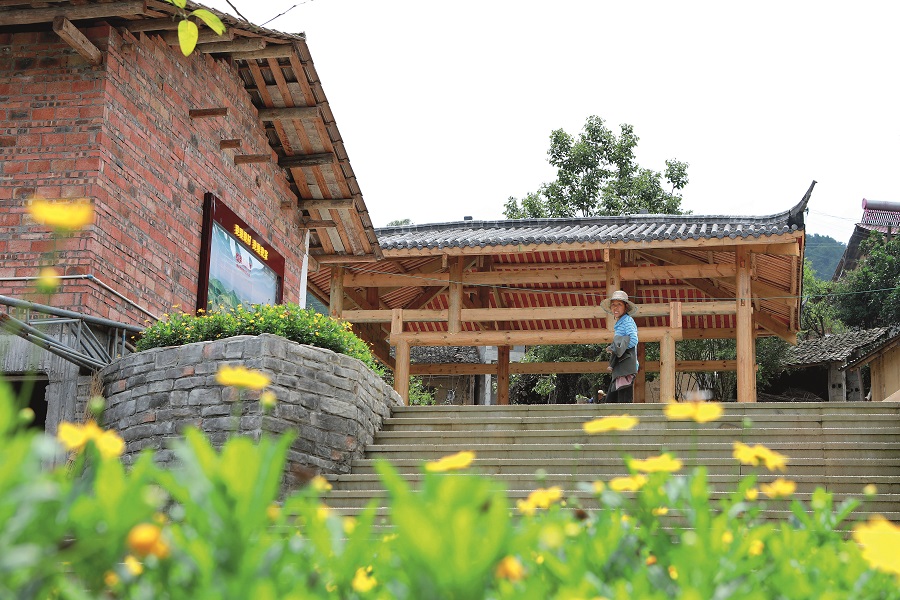Filling the Void

Fengdu County in southwestern China’s Chongqing Municipality is situated at the heart of the Three Gorges Reservoir area. It is known as a tourist destination of historical and cultural significance along the Yangtze River, but its mountainous and sparse land has hindered the county’s development. In 2002, Fengdu became a key national-level county for poverty alleviation and development. Although it had been removed from the list of poverty-stricken counties by the end of 2017, there are still 28 villages in extreme poverty, which has remained a difficult dilemma to overcome.
A “Hollowed Village”
Qingtian is a severely impoverished village 80 kilometers north of the county seat of Fengdu. According to Liu Dingfu, secretary of the village’s Communist Party of China (CPC) branch, Qingtian has a registered population of more than 1,200 people, but fewer than 200 permanent residents aged between 18 and 50 remain in the village. The rest are the elderly and children.
Even middle-aged women were reluctant to stay, knowing that they could earn much more money by working elsewhere. In most circumstances, they are forced to stay to take care of sick seniors.
Currently, Qingtian has 248 registered impoverished people from 61 households. Thanks to unremitting efforts since 2014, a total of 237 people from 56 households in the village have been lifted from poverty. With the rapid progress of urbanization in China, “hollowed villages” in rural areas like Qingtian are becoming increasingly common. Fewer people live in rural areas, fewer young and middle-aged workers stay behind and many houses sit vacant. Some rural villages are almost entirely populated with the old, weak and disabled.
Most aged villagers earn some income by picking up odd jobs. The oldest employed in weeding a tea garden is 75, and the youngest is 54. Their sons, daughters and grandchildren all work outside the county and return only once a year. “Almost everyone is like this, with few exceptions.”
To achieve the key goal of eradicating poverty by 2020, targeted poverty alleviation for such “hollowed villages” is vitally important in the critical period of the final leg of the poverty alleviation drive. But without enough young labor force, who will take the lead in helping the poor? As officials across the country continue exploration, the “Qingtian Village Model” has provided solid ideas to address the problem.
Qingtian Village Model
The declining population left unused houses throughout the village. Some houses have been renovated and developed by the village committee after consultation with villagers. Others are dilapidated and need to be renovated and reconstructed. Recently, an old building was completely renovated into a workshop for villagers to hold meetings, entertain and watch operas. The original messy village has taken on a whole new look.
Rural infrastructure is mainly funded by the government. In addition to increasing investment to improve living conditions, the government also compensates villagers for their labor when they complete construction work. This enables government investment to go directly into the pockets of villagers. The improvement of the rural environment can attract young and middle-aged migrant workers to return home and start businesses. “The villagers stand by the principle of achieving shared growth through co-governance and collaboration,” declared a township leader stationed in the village.
Last year, the county government attracted investment and transferred villagers’ land to tea enterprises. According to the “3+3+4” cooperative poverty alleviation mechanism, 30 percent of the income over the next three to five years will be collected by the village committee (one third of which is subsidized to poor households), 40 percent will go directly to villagers, and the enterprises will keep the remaining 30 percent.
“Every household will get a transfer fee of 80 yuan per mu (around US$175 per hectare),” added Liu. “Furthermore, villagers can earn 60 yuan (US$8.72) per day by doing jobs in tea enterprises such as preparing soil and weeding. Land circulation prevents enterprises from suffering losses in the poverty alleviation model while helping villagers out of poverty.”
“The key to poverty alleviation is stimulating endogenous dynamics,” revealed Li Wuzhou, a member of the standing committee of the CPC Fengdu County Committee. “A sense of gain and forward vision can push poverty alleviation. The living environment has improved, and the people certainly support the government’s poverty alleviation policy.”
A microcosm of China’s poverty alleviation in rural areas, Qingtian Village is rising like a phoenix from yesterday’s quagmire of poverty.